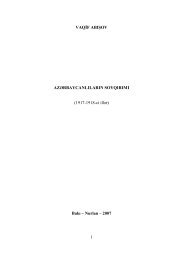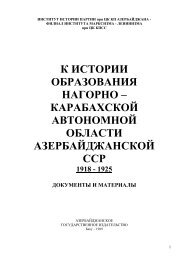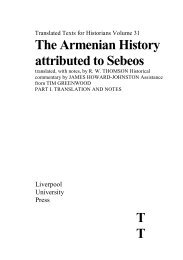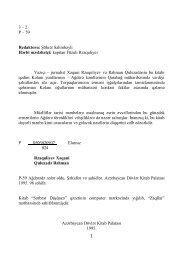ARMENIAN - Erevangala500
ARMENIAN - Erevangala500
ARMENIAN - Erevangala500
Create successful ePaper yourself
Turn your PDF publications into a flip-book with our unique Google optimized e-Paper software.
From Boston Harbor the American missionaries set out on a<br />
new "Crusade" - as they themselves saw it - to make the Holy<br />
Land Christian again. Unfortunately, the missionaries had no<br />
success at all among the Jews or the Moslems, but only among<br />
the Armenians, in other words Christians, who were being<br />
lured away from their ancestral church.<br />
archy did not pay enough attention to the educational<br />
needs of the highly intelligent Armenians. Secondly, it<br />
was practically drowning in wealth and power. The<br />
Americans finally opened their mission headquarters in<br />
Constantinople under the direction of William Goodell. In<br />
studying the history of the American missionaries in the<br />
38<br />
Ottoman Empire, it is quite intriguing to follow the story<br />
o f all the wrong turns the missionaries took before they<br />
finally recognized with great relief that the capital of the<br />
huge empire was also without a doubt the best location<br />
for their headquarters.<br />
The studies done by the missionaries Smith and Dwight<br />
soon confirmed the pattern established in Beirut and<br />
Smyrna. The Armenians, hungry for learning, gratefully<br />
and eagerly accepted the education offered by the<br />
"American Board o f Commissioners for Foreign<br />
Missions” in Constantinople.<br />
As early as 1833, many Armenian students, eager for<br />
learning and knowledge, were converting to Protestantism.<br />
In the same year, the Protestant mission already had<br />
more than fifteen young Armenian clergymen. The missionary<br />
wave soon spread from Constantinople into the<br />
provinces. In 1834, Benjamin Schneider opened a mission<br />
in Bursa. Another in Trabzon soon followed. Five<br />
years later, in 1839, came the beginning of what the<br />
Protestant Armenian-Americans refer to in their historical<br />
writings as the "spirit of persecution". The Armenian<br />
orthodox clergy had become uneasy about the incredible<br />
success that the American missionaries were having<br />
among the most talented and capable Armenians. They<br />
launched an effort to get rid of the missionaries and win<br />
back the Armenians who had gone astray.<br />
When persuasion did not work, the church turned to<br />
force. Schools were burned to the ground, and according<br />
to the missionary chronicler William E. Strong, "arrests<br />
were made and terror spread". The patriarch was deposed<br />
for being too tolerant, and a list was drawn up of roughly<br />
five hundred "principal suspects". They belonged to<br />
the highest social classes o f the Armenian millet; they<br />
were bishops, bankers, businessmen and artists; and they<br />
were all accused of heresy. That meant expulsion from<br />
the Gregorian Church, which at that time was equivalent<br />
to losing one's nationality - a personal catastrophe for<br />
those affected. Without membership iri a millet, one<br />
could not marry or have a Christian burial. One enjoyed<br />
no protection under the law and was subject to social<br />
ostracism.<br />
Nevertheless, Protestantism continued to gain ground<br />
among the Armenians. This was undoubtedly due to the<br />
fine abilities of the American-Armenian clergy, as well as<br />
the thirst for learning o f the Ottoman Armenians. A Protestant<br />
mission even sprung up in Van, practically the farthest<br />
corner of the huge Ottoman Empire, and the Protestants<br />
won converts among the "Mountain Nestorians"<br />
in the distant Hakkari Mountains. Protestantism did not<br />
bring much luck to either the Nestorians or the people of<br />
Van, however. Both the Armenians and the Nestorians<br />
started collaborating with the Russians (using American<br />
money) and finally drifted into the revolt movement of<br />
March, 1915. The Ottomans responded with a general<br />
relocation order. That was the beginning of the Ottoman-<br />
Armenian catastrophe o f 1915, which claimed so many<br />
tragic victims on both sides.

















